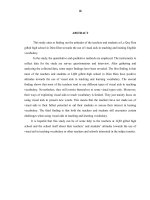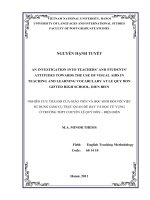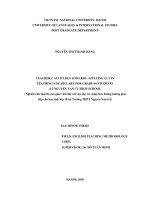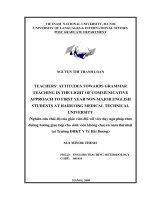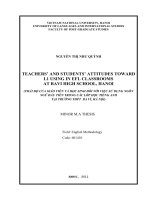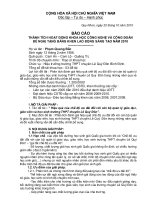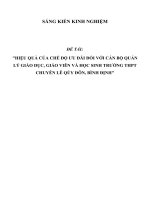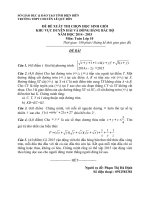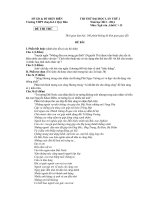nghiên cứu thái độ của giáo viên và học sinh đối với việc sử dụng giáo cụ trực quan để dạy và học từ vựng ở Trường THPT chuyên Lê Quý Đôn - Điện Biên
Bạn đang xem bản rút gọn của tài liệu. Xem và tải ngay bản đầy đủ của tài liệu tại đây (1.72 MB, 49 trang )
iii
ABSTRACT
This study aims at finding out the attitudes of the teachers and students at Le Quy Don
gifted high school in Dien Dien towards the use of visual aids in teaching and leaning English
vocabulary.
In the study, the quantitative and qualitative methods are employed. The instruments to
collect data for the study are survey questionnaires and interview. After gathering and
analyzing the collected data, some major findings have been revealed. The first finding is that
most of the teachers and students at LQD gifted high school in Dien Bien have positive
attitudes towards the use of visual aids in teaching and learning vocabulary. The second
finding shows that most of the teachers tend to use different types of visual aids in teaching
vocabulary. Nevertheless, they still restrict themselves to some visual types only. Moreover,
their ways of exploiting visual aids to teach vocabulary is limited. They just mainly focus on
using visual aids to present new words. This means that the teachers have not made use of
visual aids to their fullest potential to aid their students or arouse their interest in leaning
vocabulary. The third finding is that both the teachers and students still encounter certain
challenges when using visual aids in teaching and learning vocabulary.
It is hopeful that this study can be of some help to the teachers at LQD gifted high
school and the school itself about their teachers’ and students’ attitudes towards the use of
visual aid in teaching vocabulary or other teachers and schools interested in the subject matter.
iv
LISTS OF ABBREVIATIONS
LQD
Le Quy Don (gifted high school)
No.
Number of informants
RO
Real objects
v
LISTS OF FIGURES AND TABLES
List of figures
Pages
Figure 1:
Data collected from question 1 of the teachers’ questionnaire
19
Figure 2:
Teachers’ interest in using visual aids to teach vocabulary
20
Figure 3:
Teachers’ evaluation of the visual aids in general
20
Figure 4:
Data collected from question 5 of the teachers’ questionnaire
21
Figure 5:
Data collected from question 9 of the teachers’ questionnaire
24
Figure 6:
Data collected from question 12 of the teachers’ questionnaire
26
Figure 7:
Students’ interest in learning vocabulary through visual aids
28
Figure 8:
Students’ evaluation on the usefulness of visual aids in vocabulary teaching
28
Figure 9:
Data collected from question 3 of the students’ questionnaire
28
Figure 10:
Students’ preference of the sources of the pictures
30
Figure 11:
Students’ preference of the sources of real objects
30
Figure 12:
Data collected from question 10 of the students’ questionnaire
32
Figure 13:
Teachers’ attitudes towards the importance of vocabulary in language teaching
33
Figure 14:
Data collected from question 2 of the interview for the teachers
33
List of tables
pages
Table 1:
The teachers’ evaluation of the specific visual aids
21
Table 2:
The teachers’ frequency of visual aids use in teaching vocabulary
22
Table 3:
The teachers’ ways of using of visual aids to teach vocabulary and the
frequency of the teachers using these ways to teach vocabulary
23
Table 4:
The types of visual aids and their impressions on the students
23
Table 5:
The teachers’ frequent sources of getting visual aids
24
Table 6:
The teachers’ reasons for using visual aids in teaching vocabulary
25
Table 7:
The challenges faced by teachers when using visual aids to teach vocabulary
26
Table 8:
The students’ evaluation of visual aids in facilitating their vocabulary learning
29
Table 9:
The students’ evaluation on their teachers’ frequency of using visual aids to
30
vi
teach vocabulary
Table 10:
The reasons for the students’ interest in learning vocabulary through visual aids
31
Table 11:
The reasons for the students’ de-motivation in learning vocabulary
through visual aids
32
Table 12:
The problems faced by the students when learning vocabulary through visual aids
33
Table 13:
Teachers’ favorite ways of teaching vocabulary
34
vii
TABLES OF CONTENT
Page number
DECLARATION
i
ACKNOWLEDGEMENT
ii
ABSTRACT
iii
LISTS OF ABBREVIATIONS
iv
LISTS OF FIGURES AND TABLES
v
TABLE OF CONTENT
vii
PART A: INTRODUCTION
1
1. Rationale of the study
1
2. Aims of the study
2
3. Research questions
2
4. Scope of the study
2
5. Methods of the study
3
6. Design of the study
3
PART B: DEVELOPMENT
4
CHAPTER 1: LITERATURE REVIEW
4
1.1. Vocabulary
4
1.1.1. What is vocabulary?
4
1.1.2. Classification of vocabulary
5
1.1.2.1. Vocabulary classified according to the concept of morpheme
5
1.1.2.2. Vocabulary classified according to the meaning
5
1.1.2.3. Vocabulary classified according to the functions
5
1.1.2.4. Vocabulary classified according to the frequency of use
6
1.2. Vocabulary and its significant role in language teaching and learning
6
1.3. Visual aids
7
1.3.1. Definitions of visual aids
7
1.3.2. Types of visual aids
8
1.3.2.1. Chalkboards
8
1.3.2.2. Real objects and presentational objects
9
1.3.2.3. Mime (Gesture and Facial expressions)
9
viii
1.3.2.4. Pictures
10
1.3.2.4.1. Wall pictures and wall charts
11
1.3.2.4.2. Flash cards
12
1.3.2.4.2.1. Word flash cards
12
1.3.2.4.2.2. Picture flash cards
12
1.4. Benefits of using visual aids to teach vocabulary
14
CHAPTER 2: METHODOLOGY
16
2.1. Research question
16
2.2. Subjects of the study
16
2.2.1. The students
16
2.2.2. The teachers
16
2.3. The instruments
17
2.3.1. The questionnaires
17
2.3.1.1. The teachers’ questionnaire
17
2.3.1.2. The students’ questionnaire
17
2.3.2. The interview for the teachers
18
CHAPTER 3: DATA ANALYSIS AND DISCUSSION
19
3.1. Data analysis
19
3.1.1. Results from the survey questionnaires
19
3.1.1.1. Results from the teachers’ survey questionnaire
19
3.1.1.2. Results from the students’ survey questionnaire
28
3.1.2. Results from the interviews for the teachers
33
3.2. Findings and discussion
36
PART C: CONCLUSION
38
4.1. Summary of the study
38
4.2. Recommendations
38
4.3. Limitations and suggestions for further study
40
REFERENCES
41
APPENDIX 1
I
APPENDIX 2
IV
APPENDIX 3
VIII
1
PART A: INTRODUCTION
1. Rationale of the study
Wilkin (1972: 110) states that “Without grammar very little can be conveyed, without
vocabulary nothing can be conveyed”. This means that to be a competent English
communicator, one must acquire a good knowledge of English grammar and have a rich
amount of English vocabulary as well. Vocabulary is an essential element of language.
Whether in speaking or writing, learners need vocabulary to communicate and understand
others. In many cases, learners produce grammatically incorrect sentences, but they still get
their message across if they use key words appropriately. In other cases, learners may feel
uncomfortable because they fail to employ certain words, or do not know the words to express
themselves. For these above reasons, we cannot deny the importance of vocabulary in learning
a foreign language.
However, for many students at Le Quy Don gifted high school in Dien Bien, learning
vocabulary is really a hard job. They find it difficult to remember a huge number of new words
they have encountered in each lesson. It often takes them a lot of time and energy to learn
vocabulary. However, they cannot remember them for long. Additionally, many students can
not communicate or express themselves with the target language because they lack vocabulary.
As a result, many students often ask their teachers the same question about how they can learn
vocabulary effectively. As a matter of fact, what students are wondering is also a big question
that always bare in the teachers’ mind which urges them try to find a suitable solution to better
facilitate both the teachers’ and students’ vocabulary teaching and learning process.
The idea of using visual aids to better aid students learn vocabulary has been
conducted at LQD gifted school by many teachers including the researcher and all agree that
visual aids are of great use to aid both the teachers and their students in teaching and learning
vocabulary. Many students admit that they can remember new words more easily by both
listening to their teachers and looking at the visuals. They also get involved to the lesson more
actively by guessing the words’ meaning through the visuals, describing the visuals, asking
and answering questions related to the visuals, etc. Therefore, students gradually retain more
words and can better communicate in the target language. For teachers, many agree that they
2
can reduce their talking time of explaining new words in stead of introducing words directly
through different types of visual aids.
From what the teachers and students have mentioned about some of benefits of visual
aids, the researcher can partly know about their attitudes towards the use of visual aids in
teaching and learning vocabulary. This inspires the researcher to conduct the study entitled
“An Investigation into Teachers’ and Students’ Attitudes towards the Use of Visual Aids in
Teaching and Learning Vocabulary at Le Quy Don Gifted High School, Dien Bien.” with hope
of understanding more about not only the teachers’ and students’ attitude towards the use of
visual aids but also the overall problems faced by them in teaching and learning vocabulary
through visual aids. Hopefully, this study will be of some values to those who want to improve
their vocabulary teaching, especially by means of visual aids.
2. Aims of the study: The study aims at:
- Investigating the teachers’ and students’ attitudes towards the use of visual aids in teaching
and learning vocabulary.
- Exploring the extent to which visual aids have been used in vocabulary teaching and learning
- Finding out the possible problems faced by the teachers and students in teaching and learning
vocabulary through visual aids.
3. Research questions: In order to achieve the above-stated goals, the study was carried out to
seek answers to the following questions:
1. What are the teachers’ and students’ attitudes towards the use of visual aids in
teaching and learning vocabulary?
2. To what extent have visual aids been used in teaching and learning vocabulary?
3. What are the problems faced by the teachers and students when teaching and
learning vocabulary through visual aids?
4. Scope of the study
This research focuses on investigating the teachers’ and students’ attitudes towards the
use of visual aids in teaching and learning vocabulary in LQD gifted high school in Dien Bien.
In fact, there are many different types of visuals that can be used to help the students better
learn vocabulary. However, due to the minor scope of this thesis, the research only aims at
3
several types of visual aids such as pictures, chalkboards, real objects, mime-facial
expressions which are available in class or can be easily made and applied by the teachers.
Additionally, the study has not dealt with students of all levels but just 11
th
form students who
have been familiar with their teachers’ method of teaching vocabulary through visual aids
since they were in grade ten.
5. Methods of the study
In the study, data was collected by two methods: survey and interview. The survey
consists of two questionnaires, one for the teachers and the other for the students. The
questionnaire for the teachers is to find their attitudes towards the use of visual aids in
teaching vocabulary and problems they have encountered while teaching. Also, the
questionnaire for the students has the same purposes. After that, all collected data will be
synthesized and analyzed statistically. Besides, the researcher conducted informal interviews
with the teachers in order to supplement the survey questionnaires. It is hopeful that the
combination of the two methods would make the data more valid and reliable.
6. Design of the study: This study is divided into three main parts:
Part A: INTRODUCTION: In this part the rationale, the aims, the research questions,
the scope, the methods and the design of the study are presented.
Part B: DEVELPOMENT: This part consists of three chapters.
Chapter 1, the “Literature Review” provides the theoretical background of vocabulary, a
brief view of some visual aids and the benefits of using visual aids in teaching vocabulary.
Chapter 2, “Methodology” presents a brief view on the subjects, the instruments and
procedures to collect data employed to seek for the answers to the research questions.
Chapter 3, “Data Analysis and Discussion” is the main part of the study. In this chapter,
the data from the survey questionnaires and the interview will be analyzed and discussed.
Part C: CONCLUSION: This part offers a summary of the study and some suggestions
for further study.
4
PART B: DEVELOPMENT
CHAPTER 1: LITERATURE REVIEW
1.1. Vocabulary
1.1.1. What is vocabulary?
Vocabulary is a matter to which many linguists and language teachers have paid much
attention, especially in providing definitions of vocabulary. In fact, there are number of
definitions of vocabulary due to different views on it. Generally, each linguist gives his/her
own definition of vocabulary depending on the criteria that he/she considers the most important
in terms of semantics, linguistics, lexicology, etc. Therefore, it is hard to provide an exact
definition of vocabulary. Below some definitions of vocabulary are presented.
According to The Longman Dictionary of Language Teaching and Applied
Linguistics, vocabulary is defined as “a set of lexemes, including single words, compound
words and idioms”. Otherwise, in the Oxford Advanced learner’s Dictionary, vocabulary is
defined quite simple as “all the words that a person knows or uses.”
Penny Ur (1996: 60) offered a definition of vocabulary “vocabulary can be defined,
roughly, as the words we teach in the foreign language. However, a new item of vocabulary
may be more than a single word: a compound of two or three words or multi-word idioms”
In Stahl’s view, vocabulary is the knowledge of words and word meanings then he
offered a clear and specific definition of vocabulary by saying that “vocabulary knowledge is
knowledge; the knowledge of a word not only implies a definition, but also implies how that
word fits into world.” (Stahl, S.A. 2005). The author emphasizes that when learning
vocabulary, learners must acquire the knowledge of words or word meanings and understand
how the word they have learnt can be used appropriately in the real-world situations.
In conclusion, although definitions of vocabulary are numerous, none can certainly
cover all the aspects and ideas of what vocabulary is. However, from the above definitions, we
can see that the centre of vocabulary is word, so the study of vocabulary can be understood as
the study of words or word meanings. This is also the concept adopted in this thesis.
5
1.1.2. Classification of vocabulary
There have been different ways of classifying vocabulary. However, classifying
vocabulary according to different criteria such as morpheme, meaning, function, frequency of
use, etc, can be considered as common methods. It is necessary for language teachers to
understand these different methods of classifying vocabulary because thanks to these, teachers
can help students to master vocabulary of a language.
1.1.2.1. Vocabulary classified according to the concept of morpheme
McCarthy (1990: 5) divides words into three kinds: simple, derived and compound.
+ Simple word : A simple word is one that consists of only a root morpheme, which can not be
further subdivided such as eat, do, learn, live
+ Compound word: Compound words are items that consist of more than one root but have a
single identity in that they name a single thing or concept such as sewing machine,
campground, electric fan
+ Derived word: A derived word is one that consists of a root and one or more derivational
morphemes such as teacher, worker, helpful
1.1.2.2. Vocabulary classified according to the meanings
A word can possess two kinds of meaning: Lexical meaning and grammatical meaning.
Read (2000: 18) states that vocabulary can be divided into notional words and functional
words.
+ Notional words are words with clear lexical meaning. They address objects, actions,
qualities, etc, and they have meaning in themselves. Notional words form a great number of
each speaker's vocabulary. For example, a boy, a ball, to make, to go
+ Functional words are words which only have meaning in relation to the other words with
which they are used. Functional words are particles, articles, prepositions, auxiliaries,
conjunctions, etc. For instance, on, for, at, the, and, because
1.1.2.3. Vocabulary classified according to the functions
In a sentence, word can possess many different functions. Therefore, English words
can be classified into different items basing on functions as different parts of speech. These
parts of speech can be nouns, verbs, adjectives, adverbs, prepositions and pronouns (Quirk,
6
1987: 18). Each part of speech has its own position, complying with certain grammatical rules
and relating to others. So that when learning English words, learners need to be aware of the
parts of speech of that word in sentence in order to understand the word clearly.
For example: - I want a cup of water. (a noun)
- Can you water the flowers for me? (a verb)
In this case, students may misunderstand between the two functions of the word
“water”. Hence, teacher needs to clarify that the word “water” in sentence “I want a cup of
water” is functioned as a noun, otherwise, the one in sentence “Can you water the flowers for
me?” is a verb. Also, teacher needs to point out that a word can have more than one
grammatical function, for instance, “like” can be a verb or a preposition.
1.1.2.4. Vocabulary classified according to the frequency of use
It is impossible for teachers to teach students every new word they come across instead
of making them be aware of words with high frequency in use and those with low frequency.
Therefore students can save more time and energy to learn words they can use more
frequently.
For instance, words used to denote daily activities or routines are often employed by
students such as to work, to learn, to go, to do (High frequency of use). Whereas, lots of
words are only used in some specific fields, for example, word processor, main board,
wizard (Low frequency of use)
Apart from classifying words basing on their frequency in use, Hermer, J. (1993: 159)
divides vocabulary basing on the two types of active and passive words.
+ Active words refer to words that students have been taught or learnt and which they are
expected to be able to use. In teaching active vocabulary, it is worth illustrating the word’s
uses through examples, so that students can find it easier to see how the word is used.
+ Passive words refer to words that students will recognize when meeting them but they will
probably not able to produce such as USB, URL, CPU
1.2. Vocabulary and its significant role in language teaching and learning
In learning a foreign language, vocabulary plays a key role because words, the centre
study of vocabulary, are considered as tools we use to access our background knowledge,
7
express ideas and learn about new concepts. Therefore, what every language learner needs to
learn foremost is vocabulary. Also, the first thing the teacher should do is teaching vocabulary.
Usually, when teaching a new language, teachers first teach some words that are simple
but powerful enough to encourage communication from the beginning. Students learn the
words’ meanings, spelling, pronunciation then they can use words to communicate with their
teachers and classmates while they do not understand much about grammar, tenses, etc. They
may make “grammar” mistakes while speaking but very often the teachers and their classmates
still understand what they want to convey anyway because words are small pieces of language,
which carry bit of meaning. Regarding this matter, Wilkin (1972: 110) claims that “Without
grammar, very little can be conveyed, without vocabulary nothing can be conveyed”.
Therefore, it is important for teachers to teach vocabulary from the very start.
Gradually, students grasp more and more vocabulary and they are able to communicate
better and better. Also, they can learn and develop grammar, writing, reading as well as
listening better and more easily, because vocabulary are means to help them understand
knowledge of a language. It is obvious that the more words students know well, the more
successful they are in communication. However, it is not always true that knowing many
words guarantee a person will be able to speak a language, but not knowing enough words can
prevent a person from effectively speaking or understanding a language. In short, teachers and
students must pay much attention to vocabulary when teaching and learning a foreign
language because it is a crucial aspect of a language that helps any language learner
understand a language.
1.3. Visual aids
1.3.1. Definitions of visual aids
In the Dictionary of English Language and Culture, visual aids are defined as
“something that people can look at to help them understand, learn, remember, etc. such as a
picture, map, photograph, or film. Visual aids are often used as materials in education” (1998:
1490). Andrew and Safia (1991) define visual aids as “anything learners can see used for
different purposes in a language class.” From these two definitions, we know that the so-
8
called “visual aids” can be considered as things that can be visualized and aid or facilitate
language learners in their learning process, especially vocabulary learning.
1.3.2. Types of visual aids
Some different types of visual aids are black-board, chart maps, pictures, photographs,
posters, film strips, slides and real or presentational objects that can help facilitate the
language teaching and learning process. They are extensively used for conveying meaning and
are particularly useful for teaching concrete items of vocabulary. However, in this minor
thesis, the author only concentrates on aids that are available in class or teachers can make
themselves. Therefore, such visual aids as chalkboards, real objects, mime-facial expressions
and some different types of pictures including wall pictures and wall charts, flash cards, etc.
are mentioned in this part.
2.3.2.1. Chalkboards
Chalkboards are commonly found in most classes. They are usually black or green,
cheap to install, easy and cheap to use and very adaptable. Teachers can use them whenever
they like to teach a lesson. Hence, chalkboards are said to be the most common and helpful
visual aids for every teacher.
There are many ways the board can be used in class to support teaching. In Using the
Board in the Language Classroom, Dobbs (2001: 4-5) presents a variety of ways to use the
board as a great teaching tool in class. Firstly, teachers can use the board to create drawings
such as stick figures or abstract forms for students to compose oral or written stories about
them. In addition, the board can be used to present new concepts to students. This means that
students can understand and remember new concepts their teachers are saying or introducing
better at the same time looking at what teachers are writing on the board. Also, teachers can
use the board to explain, clarify, illustrate, emphasize, organize, drill, and list information.
From what Dobbs states, it is undeniable that chalkboards are really good teaching tools that
support teachers a lot in class.
More importantly, chalkboards are teaching aids of really much help for teachers in
teaching vocabulary due to the ways teachers exploit the boards. For example, in order to
present a new word, teacher can both write the word spelling and draw a simple picture or
9
figure to illustrate that word instead of explaining the word wordily. Also, they can stick or
hang a picture or a photograph on the board to present new words. Exploiting the chalkboards
to teach vocabulary like this may help students learn new words more easily and teachers also
makes their lessons more interesting.
1.3.2.2. Real objects and presentational objects
In my views, real objects are simply known as things that teachers show or present to
their students as means of illustration for the purpose of learning. Many objects are available
in the classroom such as table, chairs, desks, electric fans, many students’ learning tools, etc.
While many others are portable enough to be brought to class by teachers, for example: a
camera, a ball, a box, a flash lamp, a compact dish, many types of fruits, etc.
In fact, many language teachers prefer using real objects to other types of visual aids in
teaching vocabulary. Because teachers do not have to put much effort and energy to explain
new words in speech instead of giving their students real objects to illustrate the things
teachers want to explain. According to Allen (1983: 4), real objects are of great value to show
the meaning of a new word, especially when the objects are available in the classroom. She
reinforced that “in most cases, a picture of something is less helpful than the thing itself”. She
also gives the general recommendation “for showing the meaning of an English noun, use the
real object whenever possible” (p25).
Representational objects are objects that can replace real objects in case teachers and
learners cannot bring the real ones for use in classroom.
1.3.2.3. Mime (Gesture and Facial expressions)
Mime is a type of acting using only gestures and facial expressions. According to
Alton (2002), “A gesture is a form of non-verbal communication made with a part of the body,
used instead of or in combination with verb communication.” Facial expressions are also
simply known as the expression on a person's face, resulting from specific use of the facial
muscles. Gestures and facial expressions can be considered as the cheapest among all types of
visual aids because they cost teachers nothing but energy to show gestures and express their
faces. Nevertheless, these kinds of visual aids can bring about considerable effects in teaching
10
vocabulary. They are often used to supplement other ways of conveying meaning. They are
also easy for all teachers to employ in presenting new words whenever they find it suitable.
According to Billow (1961:147), “actual presentation of an action, dramatically
presents the action better than any other picture can, because, with it, we have movement and
the third dimension, for lack of which a picture is sometimes unsatisfactory.” Through
Billow’s remark, we can see that he highly appreciates the important role of teachers’ gestures
and facial expression in a language class, especially in vocabulary teaching. Because they are
always useful illustrations, cues, contexts for presenting, practising new vocabulary items such
as meaning, action, emotion, etc. He also points out that mime is particularly useful for
presenting such actions as singing, speaking, sleeping, writing, reading, etc. Otherwise, facial
expressions are suitable to illustrate words expressing emotions, for example: happy, angry,
scared, excited, sad, disappointed, embarrassed, etc.
This is an extremely effective way of introducing new words as it resembles the total
physical response, which clearly promotes the understanding and meaningful retention of new
vocabulary items.
1.3.2.4. Pictures
There are different types of pictures that help facilitate language teachers in their
teaching process. In Look Here! Visual Aids in Language Teaching, Bowen (1982) introduces
some kinds of pictures such as flash cards, sequence pictures, wall pictures and wall charts,
etc. In fact, pictures of all kinds are considered useful visual aids in language teaching,
especially in teaching vocabulary. They can be used to illustrate very large objects which are
not easily brought into the classroom, for example: an airplane, a car, a washing machine, a
typewriter, etc. They are also of great help for teachers to stimulate students’ imagination and
memory of new words. Teachers can use pictures to clarify the denotation meaning of
vocabulary without much explanation.
It is obvious that pictures are of great help for teachers in teaching vocabulary.
Therefore, teachers should make use of all the pictures given in the textbooks as means to
teach vocabulary effectively. As a matter of fact, the number of pictures provided in the
textbook English 11 is not enough for a huge amount of new words appear in the textbook
11
English 11 so that teachers need to prepare their own pictures to serve their teaching purposes.
However, to choose or find good pictures is not easy for any teachers. Bowen (1982: 5) states
the following factors that teachers should consider before selecting a picture:
(1) Appeal: the content of the picture should capture the interest and imagination of the class
members.
(2) Relevance: The picture should be appropriate for the purpose of the lesson.
(3) Recognition: The significant features of the pictures should be within the students’ knowledge
and cultural understanding.
(4) Size: A picture to be held up before the class should be large enough to be seen clearly by all.
The detail of the picture should be visible from the back of the class. Pictures intended for
group or pair use can of course be proportionally smaller, for example: word cards or cue
cards.
(5) Clarity: For a self-made picture, its outline and its relevant detail must be clear enough with
appropriate colors. For pictures collected from other sources such as newspapers, magazines,
calendars, etc. Teachers should adapt or cut off unnecessary parts so that the pictures will not
confuse and distract students.
1.3.2.4.1. Wall pictures and wall charts
According to Bowen (1982: 13):
A wall chart is a large diagram or picture display card. Most wall charts consist of
combinations of visual and verbal material. Their aim is to give information on topic. A
wall picture, on the other hand, is simply a large illustration of a scene or event, or a set of
scenes or events.
In Visuals for the Language Classroom, Wright and Haleem (1991: 44) also offer a very
simple bur clear definition of wall picture as “Wall pictures illustrate scenes, people or objects
and are large enough to be seen by all the students”.
In general, a feature which distinguishes a wall picture from a wall chart is the way each
is used. Wall pictures (whether commercially produced or hand-drawn) are intended to be used
with the whole class. Otherwise, wall charts are for the most part unsuitable for the whole class
teaching because they are usually complex, with printing too small to be seen by the students
from their seats. By noticing this distinct feature between wall pictures and wall charts,
12
teachers can choose which picture is suitable for class work, pair work or group work. Bowen
(1982:15) points out that "Wall chart are ideal, however, for pair or group work in intermediate
and advanced classes. Work cards can be prepared to accompany the charts so that students
may work together to prepare a presentation before the whole class and/or to prepare a wall
display”.
1.3.2.4.2. Flash cards
1.3.2.4.2.1. Word flash cards
According to Bowen (1982: 25), “Word flash cards are cards on which words have been
printed and can be held up rapidly, or ‘flash’ by the teacher before the class”. He also suggests
that “a good width for flash cards is 10 cm (4inches) but the length vary according to the
number of letters in the word to be printed on the card.”
In my view, word flash cards are easy and inexpensive for teachers to prepare. They are
easy to store and carry to the classroom. Teachers can use word cards in different ways such as
holding, propping on a shelf or sticking to the board or any surfaces with adhesive plastic,
sticky tape, pins, etc.
In vocabulary teaching, word cards can be used to demonstrate exactly what the teacher
wishes and can be flashed again to consolidate learning. A well-established way of using word
cards is for the teachers to stick them on the objects in the classroom: the door, the table, a
desk, a window, etc. The intention is to familiarize students with the written form of the word.
A random collection of verbs, nouns, adjectives and adverbs can be written or printed on
word flash cards and used for exercises in identifying parts of speech.
1.3.2.4.2.2. Picture flash cards
In Wight and Haleem’s view, “picture flash cards are pictures mounted or drawn on cards
appropriately 15cm by 20cm.” (p50). They also emphasize that as for classroom use, “Picture
flash cards are more suitable for the presentation of a single concept, such as an object or an
action”. So that picture cards are considered very useful visual aids that teachers need to
employ in teaching new words during the vocabulary teaching process.
Like word flash cards, picture cards are also easy and inexpensive for teachers to
prepare which means that sets of cards related to language teaching points or to subjects matter
13
can be built over a period of time. The cards are easy to store and to carry to the classroom so
they offer considerable flexibility to the teacher in the conduct of the lesson. The cards can be
shown to the whole class or to single student which allow teachers to control who receives the
information on them. (Wright and Haleem: 1982: 50)
Normally, a picture flash card has a picture on one side only. However, both sides can be
used and the card can be folded or cut in various ways with particular teaching purposes in
mind. They can be employed in different ways by teachers to teach vocabulary effectively.
Usually it is possible for teachers to show a single picture illustrating a new word and expect it
to be understood. For example,
Sometimes it helpful to introduce contrasting language items at the same time. The two
pictures can be placed on either sides of the card. In the act of turning the card over the contrast
is demonstrated. The examples given below are can/can’t, too big/too small.
Cards can also be folded to present comparing meanings. In the example below, the
difference between ‘hill’ and ‘mountain’ is demonstrated. Each one may be seen by itself or in
comparison with the other.
14
When presenting a new vocabulary item, picture flash cards can be combined with word
flash cards in order that students can grasp the meaning, the spelling and the pronunciation of
that word spontaneously. This combination may help students remember new vocabulary items
easier and faster. When helping learners practise and revise new vocabulary items, teachers
can organize a game with both picture and word cards. The class is divided into two teams. A
student on one side flashes a picture card and a student on the other side find the appropriate
word card then pronounce it aloud, or vice versa. The picture flash cards and word flash cards
below can be designed for the game of housework.
In short, there are different types of visual aids that help language teachers facilitate their
teaching process. However, those I have just mentioned above such as chalkboards, pictures,
real objects, mime and facial expressions are useful visuals which can aid teachers a lot in
teaching vocabulary not only for vocabulary presentation but also revision.
1.4. Benefits of using visual aids to teach vocabulary
Generally, visual aids are teaching tools that many teachers can use to convey an idea
more effectively. For language teachers, visual aids are considered tools that can be used to
facilitate their teaching process in general and particularly in their vocabulary teaching process
with great benefits. Here are some of the benefits of visual aids for both teachers and students
in teaching and learning vocabulary.
Visuals better aid teachers when they have concepts or words that a piece of text or
teacher’s much explanation cannot fully convey. In this case, what teachers need to do is
employing a simple but suitable visual aid then guide students to exploit the concept or word
do the
dishes
do the
laundry
clean the
house
15
through it without wordy explanation. By using visual aids, teachers can not only present
vocabulary more effectively but they can also reduce their talking time then give students
more time to get involved in the lesson and practise the words they have learnt.
In addition, students often feel comfortable or relaxed while learning vocabulary with the
help of visual aids. Let’s compare a vocabulary teaching lesson using visual aids to a class of
teaching vocabulary through the teacher’s explanation. We can see that only listening to the
teacher’s explanation and noting down new words will make students become bored and
passive in the class. They will find it hard to remember vocabulary in such a boring way of
vocabulary teaching. They also have no chance to get involved to the lesson. On the other
hand, visual aids such as pictures, real objects, facial and gesture expression, etc. will help to
create an enjoyable and relaxing atmosphere in the classroom. Students can observe the visual
aids, listen to the teacher’s further explanation and also get involved to the lesson by describing
the pictures, teachers’ mime, guessing new words through the pictures, etc. Therefore, they can
retain more information and become active in learning.
In conclusion, visual aids are good and useful teaching tools that language teachers
should use to aid or better facilitate their teaching process, especially in teaching vocabulary.
However, in order to make use of visuals’ benefits, teachers need to understand the
characteristics of each type, know exactly why each particular item is used without depending
on them to teach a subject or overuse them.
In this chapter, some theoretical background knowledge and views on vocabulary, its
classification and role in language teaching and learning, types of visual aids and their benefits
in vocabulary teaching have been introduced to the extent that best suit the scale of the
research. In the following chapters, the process of conducting the study, the presentation and
discussion of the data collected from the questionnaires and the interviews for the teachers at
my school will be given
16
CHAPTER 2: METHODOLOGY
In this chapter, the research questions, subjects of the study, the instruments of the data
collection will be presented in detail.
2.1. Research questions
1. What are the teachers’ and students’ attitudes towards the use of visual aids in teaching
and learning vocabulary?
2. To what extent have visual aids been used in teaching and learning vocabulary?
3. What are the problems faced by the teachers and students when teaching and learning
vocabulary through visual aids?
2.2. Subjects of the study
2.2.1. The students
The participants for the study consist of 116 eleventh form students from three classes
11B1, 11B5, 11B7 at LQD gifted high school in Dien Bien. There are about 35– 42 students in
each class. They are both male and female aged from seventeen to eighteen. All these students
have been learning English for more than five years since they were in grade 6. Most of them
have got familiar with English teaching and learning methods at middle level. Among these
three classes, students in class 11B1 are major in the natural sciences, whereas, students in
class 11B5 are major in the social sciences and 11B7 is a basic class. The researcher has
chosen students from three groups to study. Therefore, the result will be more reliable.
2.2.2. The teachers
All seven female teachers and one male at LQD gifted high school are chosen as
informants of the study. All these teachers aged from 27 to 37 have been teaching English for
at least three years. Of these teachers, four graduated from the English faculty, Hanoi
University of Languages and international studies, Vietnam National University and other four
were trained at the English department, Thai Nguyen University for Teacher Training. They
are all energetic and willing to devote their time and energy to English teaching in general and
vocabulary teaching in particular. Particularly, they are very interested in applying visual aids
in teaching vocabulary to students.
17
2.3. The instruments
In order to obtain in-depth and rich data and for answering the stated research
questions, the study uses two methods of data collection: survey questionnaires and interview.
2.3.1. The questionnaires
The survey consists of two questionnaires, one is for the teachers and one is for the students.
2.3.1.1. The teachers’ questionnaire
The survey questionnaire for the teachers, consisting of 14 questions, was administered
to all eight teachers at LQD gifted high school at the beginning of March 2011. The survey
was divided into three main parts. The first five questions focus on finding out the teachers’
attitudes towards the use of visual aids in teaching vocabulary. The second part with questions
from 6 to 8 aims at exploring the extent to which visual aids have been used in teaching
vocabulary. The five following questions are raised to investigate the teachers’ problems when
applying visual aids to vocabulary teaching. The last question aims at collecting the
suggestions made by the teachers for a better exploitation of visual aids in vocabulary
teaching. All the teachers are asked to complete the questionnaires and return them in two
days. They all feel free to ask the researcher for any clarification whenever they need. The
questionnaires consist of both closed-ended and open-ended questions therefore the informants
could give their answers freely.
2.3.1.2. The students’ questionnaire
The students’ questionnaire, comprising of 11 questions, was delivered to 116 students
at the same time of the teacher questionnaire. Similarly, the survey for the students covered
three main points. The first four questions investigate the students’ attitudes towards the use of
visual aids in learning vocabulary. The second part (question 5-7) aims at finding out the
extent to which visual aids have been used to in learning vocabulary. The last four questions
explore the challenges faced by the students while learning vocabulary through visual aids. To
ensure that all of the students fully understood the questions, the questionnaires were written
in Vietnamese. All of the distributed questionnaires were handed back with answers after two
days.
18
2.3.2. The interview for the teachers
Apart from employing the survey questionnaires for the teachers and students to gather
data and information for the study, the researcher conducts informal interviews with all
teachers in order to get more insightful information to supplement the result of the teachers’
questionnaires or to interpret responses to questionnaires. Moreover, through the interview, the
researcher has the opportunity to ask for further information and go into in-depth
understanding of the teachers’ attitudes and experiences when teaching vocabulary through
visual aids. The interview of six questions (open-ended and yes/no questions) was conducted
with eight teachers individually at their class-off, therefore, the researcher can get all the
teachers’ answers without any interruption or interval.
19
CHAPTER 3: DATA ANALYSIS AND DISCUSSION
In this chapter, all the collected data from the teachers’ interview and the survey
questionnaires for both teachers and students will be presented and discussed in detail in order
to provide a summary of the results for the research questions of the study.
3.1. Data analysis
The data analysis is presented in two main parts: the first part is the presentation of the
results of the questionnaires for the teachers and students and the results of the researcher’s
informal interviews with eight teachers are provided in the second part.
3.1.1. Results from the survey questionnaires
3.1.1.1. Results from the teachers’ survey questionnaire
1. The teachers’ attitudes towards the use of visual aids in vocabulary teaching
The first five questions of the survey questionnaire are designed to find out the
teachers’ attitudes towards the use of visual aids in vocabulary teaching. In this part the
researcher will present the data of each question in succession.
100%
0%
0%
20%
40%
60%
80%
100%
Yes
No
Figure 1: Data collected from question 1
(Do you use any kind of visual aids when teaching English vocabulary?)
As can be seen from figure 1, all teachers at LQD gifted high school said that they used
visual aids during their vocabulary teaching. This reveals a fact that visual aids can be
considered as one type of popular tools of vocabulary teaching in English classes at LQD
gifted high school.
